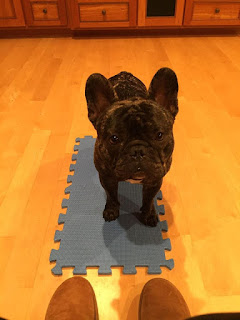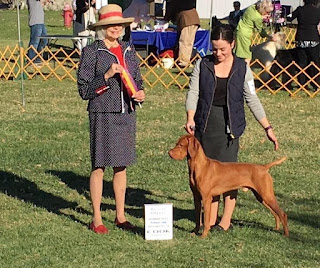When a client is having an issue with their show dog whether it is a gaiting issue or a stacking issue or an issue with the judge's exam I pull it apart using the behaviorist's most helpful tool - a functional behavior analysis. A functional behavioral analysis is a way of looking at the behavior to determine why the particular behavior is continuing to occur. This is sometimes called the ABCs of behavior. It works like this:
A = Antecedent - the antecedent is what happens just before a behavior happens, the behavior will not occur without the antecedent
B = Behavior - the target behavior we are looking at changing
C = Consequence - what happens just after a behavior
If you look at this way, from a behaviorist's standpoint you realize that the behavior is driven by the antecedent and the consequence. These two things must be in place in order for the behavior to continue to occur. The great thing is that while the animal is control of the behavior, we can change the antecedent and the consequence which will change the outcome of the behavior. Dogs, like all animals, human and non human do behaviors for an outcome. Most behavior that people complain about their dogs doing are happening because the behaviors have been reinforced, usually by the same people that complain about them.
Here is an example that I have dealt with many times:
A show dog is trained not to pull on the leash but to walk at the owner's side, the dog is reinforced for the behavior of walking and possibly punished for pulling. The owner shows the dog and is frustrated that the dog paces in the show ring. The dog is pacing because he has been taught to accommodate the speed and position of the owner. If they attempt to physically correct the dog they may end up confusing the dog because the dog is only doing what he was reinforced for. He isn't really wrong, the owner just wasn't clear or effective in teaching the behaviors in context and putting them on cue and with strong stimulus control meaning that the dog does the behavior when asked. Is it fair to correct a dog for doing what has been the right choice in the past? How is he supposed to know the difference if we don't teach it? If we did a functional behavior analysis, it would like this:
A = owner walks dog on leash
B = dog walks at owner's side
C = dogs gets a treat or to move forward on the leash
In looking at this example it is clear that the behavior has a reinforcement history. The dog is actually doing exactly what he is trained to do but the owner has now decided that they want something else. My next job is to determine how I am going to build the behavior of trotting on lead and reinforcing that so we get it on cue and the dog can either walk on leash when asked or gait on leash when asked. It is simple but not always easy to apply.
I am currently working with a dog who I have been challenged with correcting a behavior that we have actually trained and reinforced similar to the example above. Booker is a very confident and social young French Bulldog. He is being shown successfully by his owner Marcella and she has taught him how to do a very pretty and reliable free stack on cue. If she says "stack it up" he will stomp all four feet into place into a beautiful free stack. However, he will always do it at an angle and attempts to get him to straighten out result in him angling himself again. We used a stacking box and a platform with some of his stacking training and he remains on the box and straight. I am certain this happens because the free stack training and practicing has mostly been with him at her side as if she returned from a down and back with her right hand out for Booker to look at.
 |
| Booker always free stacks at an angle |
We have dropped the cue and I also needed to change the "picture" for him. Part of the cue is Marcella saying "stack it up" but dogs are also very in tune to environmental cues. Environmental cues are other things that happen while the behavior happens or just behavior that give additional information to the dog. So, Marcella standing in front of him holding his show lead has become an environmental cue for him much like you picking up the leash or putting on your hiking boots can cue the dog that you are going to go for a hike. In order to make the picture different for Booker I had Marcella sit in a chair. We still got an angle so I then added a mat that was large enough for him to stand on square but didn't allow for him to be angled. We then shaped the behavior of coming to the mat right in front of her.
 |
| The mat helps Booker to understand to stand straight rather than angled. |
To shape the behavior I had Marcella sit in a chair with the mat right in front of her feet. She would toss a treat in order to get Booker to move off of the mat and reset himself and then when he comes in straight, she marks it with "yes" and then gives him another treat, then tosses another to reset it. The idea is to figure out a way to cause the behavior to happen repeatedly so that we can reinforce it and cause it to happen more.
Once Booker began to understand it we started to put it on a new verbal cue, so Marcella would say the new cue, "front" just before Booker comes in straight on the mat. We then removed the mat and began to cue the behavior with Marcella sitting and then finally with her standing. She practiced a bit at home and in two group classes for fairly short periods of time and are already having success. They will continue to work on it so that it is reliable enough for him to do on cue in the show ring.
 |
| Coming in straight with Marcella sitting |
 |
| Booker is starting to get it and come in straight with Marcella sitting down. |
- Stop using verbal cue "stack it up".
- Shape the behavior of coming in straight in front.
- Incorporating the mat to help Booker understand to be straight.
- Changing the picture by having Marcella sit down so that it is easier for Booker to learn to come in straight.
- Once we started to get him consistently coming in straight with Marcella sitting, I had her start adding a new verbal cue "front".
- Once we had him coming in straight with the front cue, we did it with Marcella standing, but I had her position her feet a little bit apart like she did when sitting'
- We ended the session with Booker coming in straight with her standing!
- We then continue to give the verbal cue and reinforce for stacking straight in front of her.
- Success!
I was inspired to write this post because so many times people want to simply make the dog's behavior stop rather than figuring out why it is happening and figuring out the best way for the dog to have success at understanding what we are trying to teach. If an animal is exhibiting a problem behavior or any behavior that the owner would like to change the best course of action is to decide what you would like the dog to do instead, in this case stand straight, and then train that behavior. This way the dog is taught to do what is desirable, understands it and can get it right and have success.

























